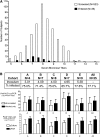Viral load drives disease in humans experimentally infected with respiratory syncytial virus
- PMID: 20622030
- PMCID: PMC3001267
- DOI: 10.1164/rccm.201002-0221OC
Viral load drives disease in humans experimentally infected with respiratory syncytial virus
Abstract
Rationale: Respiratory syncytial virus (RSV) is the leading cause of childhood lower respiratory infection, yet viable therapies are lacking. Two major challenges have stalled antiviral development: ethical difficulties in performing pediatric proof-of-concept studies and the prevailing concept that the disease is immune-mediated rather than being driven by viral load.
Objectives: The development of a human experimental wild-type RSV infection model to address these challenges.
Methods: Healthy volunteers (n = 35), in five cohorts, received increasing quantities (3.0-5.4 log plaque-forming units/person) of wild-type RSV-A intranasally.
Measurements and main results: Overall, 77% of volunteers consistently shed virus. Infection rate, viral loads, disease severity, and safety were similar between cohorts and were unrelated to quantity of RSV received. Symptoms began near the time of initial viral detection, peaked in severity near when viral load peaked, and subsided as viral loads (measured by real-time polymerase chain reaction) slowly declined. Viral loads correlated significantly with intranasal proinflammatory cytokine concentrations (IL-6 and IL-8). Increased viral load correlated consistently with increases in multiple different disease measurements (symptoms, physical examination, and amount of nasal mucus).
Conclusions: Viral load appears to drive disease manifestations in humans with RSV infection. The observed parallel viral and disease kinetics support a potential clinical benefit of RSV antivirals. This reproducible model facilitates the development of future RSV therapeutics.
Figures





Comment in
-
Evaluation of therapeutics for RSV: an important step forward.Am J Respir Crit Care Med. 2010 Nov 15;182(10):1217-9. doi: 10.1164/rccm.201008-1230ED. Am J Respir Crit Care Med. 2010. PMID: 21079265 No abstract available.
References
-
- Glezen WP, Taber LH, Frank AL, Kasel JA. Risk of primary infection and reinfection with respiratory syncytial virus. Am J Dis Child 1986;140:543–546. - PubMed
-
- Leader S, Kohlhase K. Recent trends in severe respiratory syncytial virus (RSV) among US infants, 1997 to 2000. J Pediatr 2003;143:S127–S132. - PubMed
-
- Shay DK, Holman RC, Newman RD, Liu LL, Stout JW, Anderson LJ. Bronchiolitis-associated hospitalizations among US children, 1980–1996. JAMA 1999;282:1440–1446. - PubMed
-
- Djelantik IG, Gessner BD, Sutanto A, Steinhoff M, Linehan M, Moulton LH, Arjoso S. Case fatality proportions and predictive factors for mortality among children hospitalized with severe pneumonia in a rural developing country setting. J Trop Pediatr 2003;49:327–332. - PubMed
-
- Thompson WW, Shay DK, Weintraub E, Brammer L, Cox N, Anderson LJ, Fukuda K. Mortality associated with influenza and respiratory syncytial virus in the United States. JAMA 2003;289:179–186. - PubMed
Publication types
MeSH terms
Substances
Grants and funding
LinkOut - more resources
Full Text Sources
Other Literature Sources
Medical

